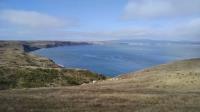
Drake's Bay
Point Reyes is a triangle of land tenuously joined to the rest of California by the famous San Andreas fault. Though part of Marin County, geologically speaking, this stretch of land has little in common with the rest of the county to the east. Point Reyes is part of the Pacific tectonic plate and originated in Mexico millions of years ago. The slow, but relentless work of the San Andreas Fault has ground Point Reyes along the coast of California to its present location.
Most visitors to Point Reyes probably get their start at the Bear Valley Visitor Station near one of the main entrances to the park. From here, there are several short trails that an introduction to the area's geological and historic features.
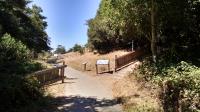
The actual earthquake induced gap is under the trees to the right. The light blue poles lined up mark the actual location of the San Andreas fault.
Several information kiosks along the Earthquake Trail highlight the active role played by tectonic plate movement in the shape of the California landscape. The most striking example is the reconstructed fence line that shows the 20 foot lateral movement of the Pacific plate with respect to the North American plate in 1906. The earthquake that caused this eery example of Earth's power also leveled much of San Francisco to the south.
The Kule Loklo Trail provides some insight into the lives of the Coast Miwok indians before the arrival of European settlers. There's a reconstructed village along the route. The structures include Kotcas, conical wooden structures that resemble teepees, as well as more substantial sweat lodges.
Cattle ranches started to sprout up here in the 1850's. At one point the dairy farms at Point Reyes were said to provide some of the best milk and cheese available in San Francisco. The cattle traditions of the area are alive and well today. A sizable percentage of Point Reyes remains under active management for cattle.
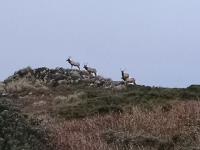
Tule Elk are plentiful along Tomales Point Trail
The Tomales Point Trail extends up a narrow peninsula to the northernmost point at Point Reyes. The trail is perhaps best known for having one of the largest concentrations of Tule Elk to be found anywhere. This subspecies of elk, found only in California, were nearly driven to extinction in the 19th century. Conservation efforts have restored them to around 4,000 individuals, many of which can be found here.
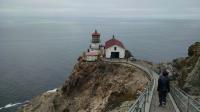
The Point Reyes Lighthouse and its support buildings.
The Tomales Point Trail is not terribly difficult, though it is one of the longer trails to be found in the park. Perhaps the most tiring aspect of the trail is the sandy surface for the last mile or so before reaching Tomales Point. Walking on sand can really tire one out.
The Point Reyes Lighthouse is widely known and this fact accounts for the large number of vehicles parked along the road leading to the start of the Point Reyes Lighthouse Trail. Numerous signs warn visitors about the 300+ steps that lead down to the lighthouse itself. Periodic rest platforms along the stairs allow those who need a breather to vacate the narrow stairs to allow others to pass.
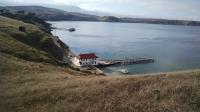
The Point Reyes Lifeboat station as seen from the Chimney Rock Trail
There are a couple of small trails that shoot out in numerous directions from the lighthouse parking area, or near it. The trail leading just to the north of the lighthouse provides good views of the ocean for whale watching at the right time of year as well as clear views of the expansive Point Reyes Beach that goes on for several miles to the north.
Not far from the lighthouse, on the opposite end of the Point Reyes Headlands, lies Chimney Rock. The Chimney Rock Trail does not have a picturesque lighthouse at the end to draw large crowds, so you're less likely to experience tourist gridlock here. To the north of the trail there are views of majestic Drake's Bay.
From the Chimney Rock trailhead, there's easy access to some historical structures that housed the Point Reyes lifeboat station. The restored lifeboat launch building once quickly slid 36-foot rescue boats down one of three rails into the water to assist the crews of ships that foundered on the treacherous rocks around Point Reyes.